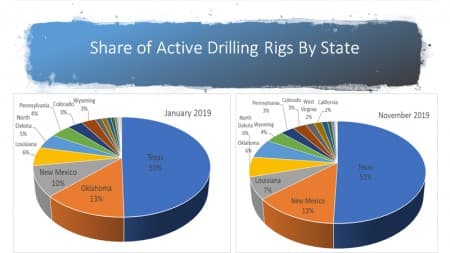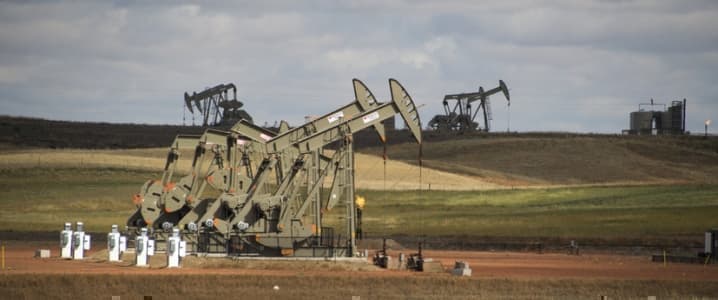The mere mention of the words “oil” and “gas” conjure up images of Texas for most Americans, and Alberta for Canadians - hands down, the two most critical hydrocarbons hotspots in North America. But with a weak Q4 market outlook in Texas and a major exodus of oil and gas companies from Alberta, it’s entirely possible that these two venues could lose their claim to the fossil fuels throne in the coming years.
Any answers to what might replace them are invariably found in the ominous rig count.
Rigs on the ground tell a much more detailed story about the state of affairs in both Texas and Alberta. And rigs are the biggest indications of the future of everything in the industry from jobs to bankruptcy.
There’s a lot riding on rigs, which is exactly why traders are obsessed with the Baker Hughes rig count that comes out every Friday. It’s also why they should be more obsessed with this than with the U.S. inventory figures that turn trading into a sideshow of inaccurate numbers and misunderstandings.
For rigs, the count is clear, and so are the implications.
Is the Falling Rig Count in Texas a Sign of Things to Come?
At the beginning of 2019, Texas single-handedly accounted for 534 of the 1,075 oil and gas rigs operating in the United States, housing nearly 50% of all active oil and gas rigs in the US. The three states that had the largest number of active rigs - Oklahoma, New Mexico, and Texas - together held nearly three quarters of all active rigs at 72.5%.
But things have shifted since the start of the year. Texas’ absolute rig count has dipped from 534 to 416. Still, it fared better than many other states, and its share of all active rigs in the United States has increased.
The Lonestar state now holds more than 50% of all active rigs in the United States. Related: The Rig Count Collapse Is Far From Over
Meanwhile, the Big 3 - or what was the Big 3 - have lost some ground, and now hold less than 70% of all the US rigs, with Oklahoma shedding 65% of its rigs year over year and giving up its No. 3 spot to Louisiana.

Even as the number of active rigs in Texas have fallen over the course of 2019, Texas is still the number one oil producer, and it is still home to the greatest number of oil and gas jobs in the country.
But a word of caution: from September 2018 to September 2019, the oil and gas industry in Texas added just 1,700 positions - the smallest number of positions added to any industry in Texas. This slowing of new oil and gas jobs is closely tied to the decreases to its absolute rig count - even as it is increasing production.
The money backing the oil and gas industry is no longer satisfied with mere increases in production - no, they want profit. And profit in today’s volatile oil market comes through belt tightening - and one of the notches on that belt is labor costs. Those who are unable to find ways to cinch that belt have been forced into bankruptcy - and Texas has seen 27 bankruptcies in the oil and gas industry since May.
Q4 isn’t looking much brighter, with Halliburton and Schlumberger - the two largest US-based oilfield services provides - expecting even more of a slowdown in customer activity than what we’ve seen this year.
But all is not lost. While oil and gas extraction-related jobs in Texas have seen a sharp decline since the boom of 2014, they are now once again on the rise - a moderate rise - even as the number of rigs falls off.

Texas’ Canadian Cousin
Canada’s Alberta province - responsible for holding 70% of all Canadian oil and gas rigs - has never faced tougher times. It has weathered mounting environmental pressures from other Canadian provinces that has stymied industry growth as critical pipeline projects flounder in regulatory and political purgatory. In the runup to 2019, Alberta’s Premier Rachel Notley instituted a mandatory oil production quota for the province, taking 325,000 bpd off the market in an effort to buoy the price of its benchmark Western Canadian Select, which was trading at a steep discount to WTI.
And its number of active rigs has reflected these tough times.
The province’s 4-week average oil and gas rig count at the start of the year was 120 rigs. Today, this figure is 97, for a 19% decrease in active rigs.
As a result, Alberta has hemorrhaged oil and gas jobs in 2019, with unemployment of young men in Alberta now at 19.9% - an increase of 4% from just one month ago. And it has also started to hemorrhage entire companies.
In 2019, Kinder Morgan divested the last of its holdings in Canada, and its most recent loss - in November - was that of Calgary-based Houston Oil & Gas Ltd, which had operated 1,200 wells in Alberta - now they have none. The week before that, Encana announced that it would relocate from Calgary to the United States. Related: The Science Behind Dark Energy
After this tough 2019, things may look up for Alberta. On Friday, those production quotas were eased for new conventional wells - a move that should encourage new drilling as companies try to make up for lost ground stemming from the quotas. And quotas had already been eased in the week prior for companies who were shipping their oil by rail.
But lifting production quotas will not help Canadian oil companies deliver their product out of the country.
Why the Rig Count Metric
Regardless of what ails the oil industry, there are a series of metrics that traders and investors use to assess the state of the industry - whether you’re interested in Canada or the United States. Baker Hughes rig count is just one of them - but keep an eye on this count.
In today’s data-driven world, it’s hard to fathom how oil and gas data - be it inventory data, shipping data, rig data, DUC well data, and production data - is anything less than accurate, but much of that data is less accurate than most people believe.
Case in point: just two weeks ago, the API supplied inventory figures as usual, and Twitter users quickly disseminated the information. But there was a problem. Sometime later - and we’re not sure how much later - the API sent out a second, corrected set of figures to its paid subscribers. A second set of figures spread through Twitter, and then through the media. Armed with two sets of data, the markets were confused. The following morning, the EIA published their own data, providing yet a third picture of how inventory moved for the week. This data is great for predicting short-term price swings.
If you want to keep your finger on what is happening with oil and gas producers, the BH rig count is tied to what they are actually doing.
What happens next in Texas and Alberta isn’t going to come down to wild numbers coming out of the API. If you want to trade on the future of Texas and Alberta, keep your eye on the rig counts and even the labor figures.
Right now, this throne is potentially up for grabs in the future.
By Julianne Geiger for Oilprice.com
More Top Reads From Oilprice.com:
- The One Metric That Matters For Electric Cars
- Russia Predicts The Death Of U.S. Shale
- Oil Prices Climb As EIA Reports Surprise Inventory Draw


















While the majority of market observers may have doubts about the accuracy of the US crude and products inventory figures that the US Energy Information Administration (EIA) and the American Petroleum Institute (API) publish from time to time, they trust the rig count that Baker Hughes publishes every Friday.
The reason is that rig counts don’t lie. They tell the truth as it is on the ground whilst the inventory figures are used by both the EIA and API to manipulate oil prices. It has not been lost on the global oil market that every time oil prices show signs of rising, either the EIA or the API or both immediately announce a build in inventories.
The fall of rig count in Texas and the fact that Texas is home to the Permian which accounts for 60%-70% of total US shale oil production confirm what numerous authoritative reports have been talking about a steep slowdown in US shale oil production and a lot of bankruptcies among US drillers.
The US shale oil industry has never ever been profitable. If judged by the standard commercial criteria by which other companies are normally judged, it would have been declared bankrupt years ago. Still, it will be no more in 5-10 years.
Dr Mamdouh G Salameh
International Oil Economist
Visiting Professor of Energy Economics at ESCP Europe Business School, London